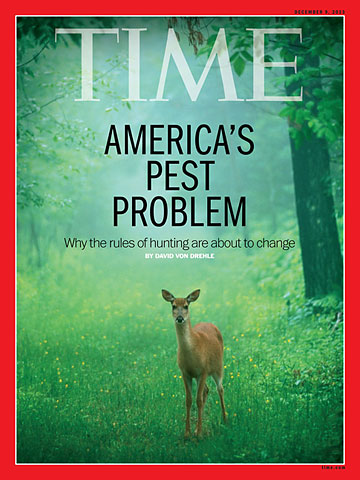
(3 of 7)
For people who had started to worry about letting their pets and small children out in the yard, that's a big improvement, and state officials would like to reduce the number of bears further. For people like child psychologist William Crain, however, the slaughter has been appalling. Crain, a professor at City College of New York, has turned out to protest the bear hunt each of the past three years; his protest last December ended when he was bundled into a state-police car while wearing a hand-lettered sign that read Mother Nature is crying.
Crain's sign points directly to the heart of the crisis. For the fact that New Jersey is teeming with bears (and all other manner of urban and suburban wildlife) has relatively little to do with Mother Nature and far more to do with you and me. In the state of nature, a burgeoning bear population would be handled efficiently and unsentimentally by a dry-eyed tyranny of starvation and disease. After the Italian explorer Giovanni da Verrazano arrived in the area in the mid--16th century, however, the state of nature--"red in tooth and claw," as the poet Tennyson put it--began its gradual transition into New Jersey, and the story got more complicated.
The first three centuries of European immigration were bad news for the bears. People cut down forest habitats for timber, charcoal and farmland, and when bears raided pigpens or smokehouses or berry patches, the humans killed them as pests. By the middle of the 20th century, so few bears remained that the state took action to protect them.
And so as with the deer, just when the bears were on the brink of extinction, humans brought them back. How? Partly it was a triumph of the conservation movement. Killing black bears was outlawed, and patches of forest were linked and converted into preserves. Partly too it was a matter of changing economics. People no longer warmed their homes and powered their machines by burning wood. Small-plot farming became a hobby of the few, rather than the livelihood of the masses. The destruction of the forests slowed, then stopped: according to the New Jersey forestry service, while the human population of the Garden State has more than quadrupled since 1900, the amount of the state that is forested--42%--has remained the same, and the quality of many of these forests has improved, as they teem with grasses and blueberries. The revival has been even more pronounced elsewhere in the eastern U.S. "Today the northeastern United States is almost 75% forested," according to Ellen Stroud, an environmental historian at Bryn Mawr College. The same pattern holds true across the Great Lakes, parts of the Midwest, the South and the slopes of the Rockies.
